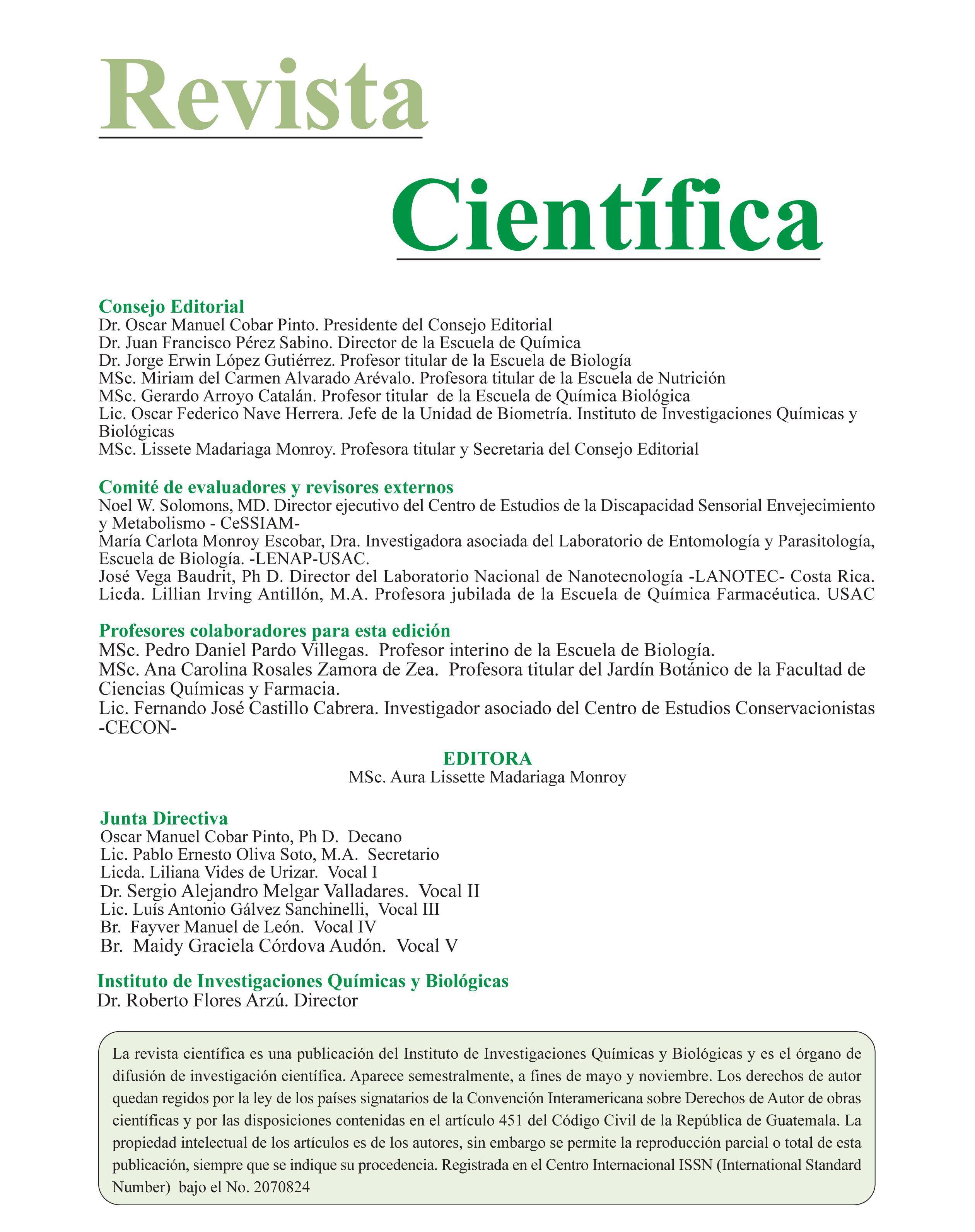Phyla dulcis (Trevir.) Moldenke: Description of diagnostic anatomical characteristics of the crude
DOI:
https://doi.org/10.54495/Rev.Cientifica.v23i1.113Keywords:
Phyla dulcis (Trevir.) Moldenke, Verbenaceae, orozus, drugAbstract
Phyla dulcis (Trevir.) Moldenke, commonly known as orozus, is a plant of the Verbenaceae family, widely distributed in Guatemala. Besides its sweetening property, orozus also possesses several medicinal properties (e.g. antibacterial, antispasmodic and anti-inflammatory properties). It is used to treat respiratory diseases such as colds, coughs and bronchitis. This species has chemical variations between different populations, which could suggest anatomy variation, including organoleptic, macroscopic and microscopic characteristics. Results of the anatomical comparison of 30 specimens of orozus from three different populations are presented, this in order to generate information that can help to validate popular uses of plants in the region, as well as to generate data for the phytopharmaceutical laboratories. Groups within and between populations were not evident in the cluster analysis performed in this study. The drug consists of aromatic dried leaves with very sweet flavor. The leaf is amphystomatic, with majorly anomocytic stomata, but paracytic and diacitic stomata can also be found. This has one-layer epidermis and cells with striated cuticle. Larger and slightly wavy walls on the upper side of the leaf were found, and smaller highly sinuate on the underside of the leaf. The blade presents abundant unicellular and multicellular trichomes, these can be simple or grounded in a rosette like cell disposition. In the underside of the leaf, the thricomes are glandular, capitated, uni or multicellular type. The mesophyll usually has two layers of differentiated pallisade parenchyma and spongy parenchyma. The central vein has the same tissues as the rest of the leaf and also has a collateral vascular bundle type. Petiole presents a one-layer epidermis, followed by 2-4 layers of collenchyma, parenchyma and U-shaped vascular bundle.
Downloads
References
Souto-Bachiller, FA, et al. (1997). Terpenoid Composition of Lippia dulcis. Phytochemestry. Vol. 44 no.6: 1077-1086. https://doi.org/10.1016/S0031-9422(96)00691-7 DOI: https://doi.org/10.1016/S0031-9422(96)00691-7
Cáceres, A. (1999). Plantas de Uso Medicinal en Guatemala. Eds. L. Girón y A. Cáceres. Guatemala, GT, Editorial Universitaria. 402 p.
Cáceres, A Ed. (2006). Propuesta de Monografías Farmacopeicas de 10 Plantas Medicinales Centroamericanas . OEA - AID (Organización de Estados Americanos OEA; Agencia Interamericana de Cooperación para el Desarrollo AICD). Guatemala, GT. 88 p.
Compadre, C et al. (1985). Hernandulcin: An Intensely Sweet Compound Discovered by Review of Ancient Literature. Science. 227: 417-419. https://doi.org/10.1126/science.3880922 DOI: https://doi.org/10.1126/science.3880922
Gattuso, M; Gattuso SJ. (1999). Manual de Procedimientos para el Análisis de Drogas en Polvo. AR. UNR Editora. s.p.
Granados, N. (2007). Establecimiento de los patrones de identidad farmacognóstica de Neurolaena lobata (L.) R. Br. ex Cass a partir de las características anatómicas de seis poblaciones silvestres. Tesis Lic. Guatemala, GT, USAC. Escuela de Biología. 85 p.
Solís, PN et al. (2005). Manual de Caracterización y Análisis de Drogas Vegetales y Productos Fitoterápicos. OEA/AICD/AE 089/03: Proyecto Desarrollo y Tecnología de Cultivo de Plantas Medicinales y Producción de Fitofármacos. 132p.
Williams, LO. (1981). The Useful Plants of Central America. Ceiba. 24: 3-342.
Downloads
Published
How to Cite
Issue
Section
License
Copyright (c) 2013 N. Granados-Dieseldorff, M. Paredes, M. Ordóñez, V. Martínez

This work is licensed under a Creative Commons Attribution 4.0 International License.
Authors who publish with this journal agree to the following terms:
- Authors retain copyright and grant the journal right of first publication with the work simultaneously licensed under a Creative Commons Attribution License 4.0 that allows others to share the work with an acknowledgement of the work's authorship and initial publication in this journal.
- Authors are able to enter into separate, additional contractual arrangements for the non-exclusive distribution of the journal's published version of the work (e.g., post it to an institutional repository or publish it in a book), with an acknowledgement of its initial publication in this journal.
- Authors are permitted and encouraged to post their work online (e.g., in institutional repositories or on their website) prior to and during the submission process, as it can lead to productive exchanges, as well as earlier and greater citation of published work.









